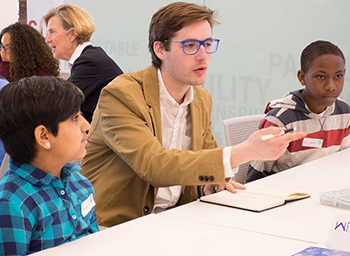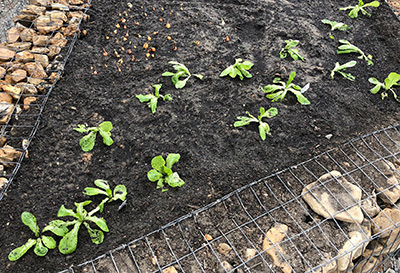In 2016, the Shawnee Mission School District in Johnson County, Kansas, embarked on a process to set sustainability goals for the district. Starting with a youth summit, the students voted on the focus areas for the coming year, which served as curriculum goals and district priorities. The group chose water, ecology and air quality, and students were immersed in learning about all three aspects and how they affect the Earth.
As part of the process, the students identified their highest priorities for the district, which included incorporating school gardens and natural areas. District officials also recognized the opportunity to incorporate these sustainability goals into a new focus on outdoor learning. As a long-time partner of the district, Hollis + Miller offered to donate the design and construction of the firm’s annual signature outdoor learning classroom – known as Learnscape – to Sunflower Elementary, which serves more than 500 students from kindergarten through sixth grade, located in Lenexa, Kansas.
The school had an open outdoor area but didn’t already have a school garden or other outdoor learning space, said Principal Ryan Kalis, which made it a good candidate for the new project.
“We were just looking to think outside the box and do something differently to engage our students,” he said. “Our staff were willing to jump in because what we had done in the past wasn’t always getting us further down the road within the realm of learning and engagement.”
 Hollis + Miller invited several students from all grade levels to the firm’s office, where they discussed the sustainability priorities and how they could be incorporated at Sunflower. Hollis + Miller’s team of Emerging Professionals (the company’s internship program) brought their expertise and fresh perspectives to the Learnscape efforts, working with all grades levels of Sunflower students to incorporate their thoughts and ideas, while also encouraging these young learners to explore the architecture field.
Hollis + Miller invited several students from all grade levels to the firm’s office, where they discussed the sustainability priorities and how they could be incorporated at Sunflower. Hollis + Miller’s team of Emerging Professionals (the company’s internship program) brought their expertise and fresh perspectives to the Learnscape efforts, working with all grades levels of Sunflower students to incorporate their thoughts and ideas, while also encouraging these young learners to explore the architecture field.
Leading design charrettes with the Hollis + Miller team and managing all the planning for the upcoming build day gave the emerging professionals the opportunity to own a project and take it through all phases of design and construction. Plus, they all brought their unique perspectives and ideas to the table, which allowed them to design a truly one-of-a-kind space for outdoor learning for generations to come. The annual philanthropic contribution allows Hollis + Miller staff to collaboratively design and build a purposefully crafted outdoor learning environment that draws students to nature, relaxes their minds and encourages focused learning, all within the grounds of the schools they occupy every day.
 Construction on the project began during the summer of 2018 and proceeded during the fall school year. The completed space encourages students to discover the natural environment by interacting with the area in different ways. Students can study water conservation benefits by utilizing the on-site cistern as they tend to planter boxes created for each grade level to learn about lifecycles and ecology. A solar panel on the roof of a large, covered deck gives students an up-close connection to alternative energy sources. Even the area’s signage doubles as a musical instrument, teaching students about the physics of sound.
Construction on the project began during the summer of 2018 and proceeded during the fall school year. The completed space encourages students to discover the natural environment by interacting with the area in different ways. Students can study water conservation benefits by utilizing the on-site cistern as they tend to planter boxes created for each grade level to learn about lifecycles and ecology. A solar panel on the roof of a large, covered deck gives students an up-close connection to alternative energy sources. Even the area’s signage doubles as a musical instrument, teaching students about the physics of sound.
To help teachers incorporate the new space in their daily routine, the district worked with the city and county as well as with resources from the district and Hollis + Miller. Joan Leavens, coordinator of sustainability and community engagement for the district, said the adjustment was both quick and welcomed.
“The teachers are excited and comfortable,” she said. “It’s now part of who they are. They’re making use of it in all kinds of ways.”
The new space provides students with hands-on experience with solar energy and gardening, and students regularly use the raised gardens, experim
ent tables and amphitheater seating area. Leavens said that each class is finding ways to incorporate more and more of their academic lessons into the outdoor space.
 “What we historically have seen is that when there’s a school garden or an outdoor learning space, it goes from, ‘I have a 30-minute lesson, can I do it outside?’ to ‘Let’s go outside, spend several hours, and we’ll do math and science and social studies, and we’ll have an experience that ties in all these curricular opportunities.’”
“What we historically have seen is that when there’s a school garden or an outdoor learning space, it goes from, ‘I have a 30-minute lesson, can I do it outside?’ to ‘Let’s go outside, spend several hours, and we’ll do math and science and social studies, and we’ll have an experience that ties in all these curricular opportunities.’”
Kalis said the school is now working to find ways to provide additional professional development for educators to use the area to its full potential. But in the meantime, he sees a lot of excitement from the students and staff.
“We’ve gone from more of a ‘free exploration’ to honing in on the priority standards to figure out how we can best utilize the space to engage the students,” he said. “But the students are very engaged and enthusiastic about the space … It’s been incredibly positive.”
Sign up to hear about the latest news from our architecture firms in Denver and Kansas City.
© 2024 – Hollis + Miller. All rights reserved.